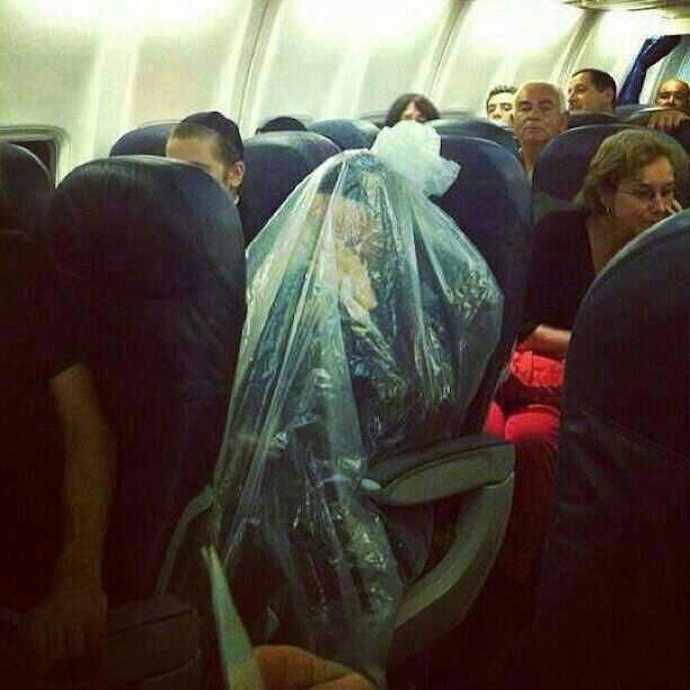Photo: Orthodox Jew Sealed In Plastic During Flight

Image via Imgur
A lot of people are superstitious about flying. They might pray, carry a lucky rabbit’s foot, sit in a certain section or perform their little OCD rituals before the plane takes off from the runway. But it’s not too often you see someone wrap himself in plastic just to take a flight. But that’s exactly what passengers on one plane recently saw when an Orthodox Jewish man bagged himself up in a plastic sheet. Apparently, the man is a Kohein—a religious descendent of Israel’s ancient high priests—and is banned from flying over cemeteries.
A photograph of the man recently went viral after it was posted on Reddit. It shows the plastic-wrapped man, dressed in black and wearing a Jewish kippah, in his seat as fellow passengers lean in to get a better look.
Kohein is the Jewish word for priest, and the holy men are believed to be direct paternal descendants of the Biblical Aaron, brother of Moses. In Biblical times, Koheins were chosen by God to perform ceremonies in connection with animal sacrifices and rituals related to the Temple. After the destruction of the second Temple, the Kohein’s role diminished, but they retained formal ceremonial roles in synagogue prayer services in Orthodox and Conservative Judaism. The Kohein is typically called to read the first blessing of the Torah—known as the aliyah— in Hebrew during synagogue services.
Believe it or not, scientific evidence supports the belief that modern Koheins are, in fact, descended from Aaron of the tribe of Levi. In a study published in 1997, DNA of Koheins in three countries was examined and found to have common elements on the Y-chromosome—an indication that the subjects all shared a common male ancestor.
So what’s the deal with flying over cemeteries? It all goes back to the Torah. According to Leviticus 21:1, “Speak to the priests, the sons of Aaron, and say to them: Let none defile himself for a dead person.” Back then, the rule meant that contact with a dead body caused ritual impurity. So in the time of the Temple, if a Kohein became ritually impure, he couldn’t enter the temple. Why? According to the Sefer HaChinuch, when the holy soul departs, the body becomes a source of impurity.
To avoid impurity, Koheins have to be pretty careful. Apparently, death is everywhere. If a Kohein can’t fly over a cemetery, he obviously can’t walk into one either, unless he says at least four cubits—about six feet—from all graves. He can’t even walk under a tree if its branches extend over a grave. And if there’s a wall around a grave, the Kohein has to stay at least five handbreadths—about 30 inches—from the wall.
There’s more: A Kohein can’t be in the same room as a corpse. If there’s a corpse in the same building he’s in—like a hospital—he has to be mindful of whether or not the doors between the rooms are closed, how the hinges are positioned and if the corpse will be taken out of the building through the room where he is standing. Not only do these rules apply to a hospitals and funeral homes, but Koheins might even become impure from entering a museum that contains human skeletons or remains.
While a Kohein is obligated to attend the funeral of his parents, children, wife, paternal brother and never-married paternal sister, he may not be able to attend the funeral of his grandparents or other relatives unless the funeral home has a special Kohein room. And he probably can’t visit their graves unless they are buried on the edge of the cemetery.
With all these rules, it’s less surprising Kohein are concerned about flying over a cemetery. At one point, an Israeli leader actually published a halkhic ruling that forbade Koheins from flying, period, because they might go over a cemetery. But the ruling was later altered, offering the plastic-bag solution for Koheins who needed to take a flight. In fact, the practice became so prevalent around Israel that in 2001 El Al Airlines decided to no longer allow the Jewish priests to seal themselves in plastic due to “flight safety considerations (that) do not allow for passengers to board while covered in seals plastic bags.”
So now we know why the Koheins seal themselves in plastic, but that still leaves one unanswered question: How do they breathe? Apparently, punching air holes in the plastic isn’t allowed because it invalidates the barrier. Hopefully they aren’t flying nonstop from Tel Aviv to New York, or there will be some flight attendants unsealing some blue Jews upon arrival.









































